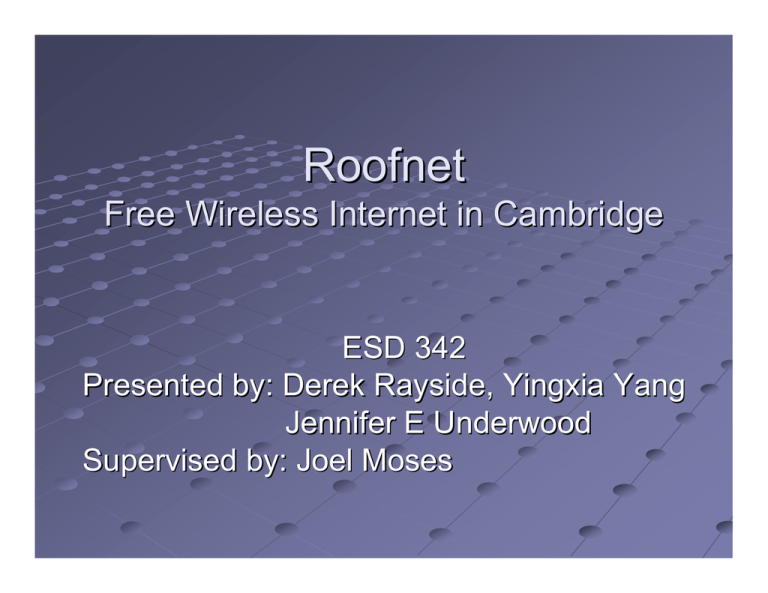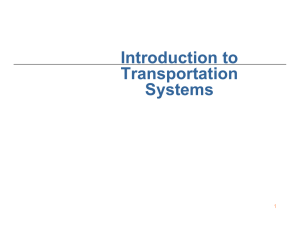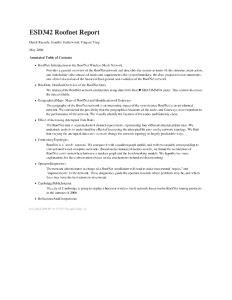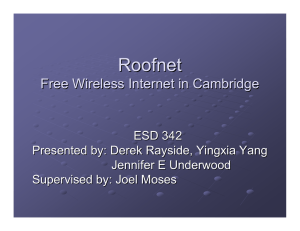Roofnet Free Wireless Internet in Cambridge ESD 342
advertisement

Roofnet Free Wireless Internet in Cambridge ESD 342 Presented by: Derek Rayside, Yingxia Yang Jennifer E Underwood Supervised by: Joel Moses Roofnet Revisited The goal of Roofnet project is to provide broadband wireless Internet access to users in Cambridge. Data Inconsistencies and Issues Coordinate data in the SIGCOMM2004 paper supplementary information: Incomplete (some nodes in traffic data not in coordinate file) Inconsistent (some lat-long coordinates do not match up with map in paper) Time stamp data not synchronized Some packets arrived before they were sent Couldn’t calculate transmission time Estimated based on s/n ratio and nominal bit rate Gateway nodes unclear… Traffic data arranged by “experiment” Attempted bit rates: 1, 2, 5.5, and 11 Mbps One node sends while others listen and record Data Inconsistencies: Coordinates and Node ID Revised Project Goals Analyse network topological properties and variation in connectivity strengths as attempted data rate increases Have analyzed for aggregate data Analyse performance of periphery nodes Indicated as problem by Roofnet group Analyse robustness In progress Analyse congestion (if time) Periphery: where’s the edge? Connectivity: Few partners Bandwidth Low s/n Geography Physical distance All 3 are different Connectivity Periphery: ≤ 4 incoming/outgoing links Nodes with Red X’s are the nodes identified as being “on the margin” No data to locate these nodes geographically These send but do not receive signals… Basic Quantitative Analysis on Aggregate Data Nodes: 41 Edges: 562 Average degree: 562/41=13.7 Maximal out-degree = 27 Maximal in-degree = 26 Average path length: 0.3760 Harmonic path length: 5.5962 Clustering Co-efficiency: 0.5625 Centrality: Degree centrality Degree centrality for out-degree: 34.063% Degree centrality for in-degree: 31.500% Betweenness centrality Network Centralization Index = 9.19% Degree distribution e e r g e d x e t r e v degree distribution 30 25 3511 22 3817 41 471215 16 26 138 24 27 3139 10 33 13 2814 34 18 23 2032 36 26 21 20 15 10 5 0 0 10 20 30 529 37 9 30 19 2540 40 50 vertex ordered index e e r g e d 8 m a 6 r g o t 4 s i h 2 0 y c n e u q n e o ir tf u b i r t s i d 0 5 10 15 20 25 30 10 0 10 0 10 1 10 2 degree 10 2 e v 1 i 10 t a l u m u c 10 0 10 0 10 1 degree 10 2 Prestige and Acquaintance Based on aggregate data Authority: not only referred to by many nodes, but also by many Hubs. (measurement: prestige) Hub: not only refers to many nodes, but also to many Authorities. (measurement: acquaintance) Asymmetry s/n not symmetrical X can talk to Y Can Y talk to X? some dramatic differences 76 one-way edges Most links are low quality Connectivity & S/N Quality <4db < 20db > 20db connectivity ≠ bandwidth “Quality” Links: Geographical Nodes with Red X’s had inconsistent data: map represents best-guess location/node ID Strongly-Connected Components Subgraph where every node can reach every other node Collapse into “meta-node” All links “Quality” links (>4db s/n) Future steps Finish analyzing variation across experiments Finish robustness analysis Random and targeted failed nodes Finish analyzing periphery nodes If time Analyze congestion in OPNET Evaluate political situation in Cambridge with regards to deploying Roofnet Back-up Slides 3-node Motifs Full list includes 2 motifs MOTIF NREAL NRAND ID STATS 108 NREAL ZSCORE NREAL PVAL UNIQ VAL CREAL [MILI] 185 153.7+-10.1 3.08 0.000 5 56.66 742 601.0+-13.2 10.68 0.000 10 227.26 001 101 100 238 011 101 110 Had ALL 13 of the possible sub-graphs Oops! Three nodes only sending signals without receiving any signals 23745, 43224, 26222 Interestingly, these nodes did not appear in the coordinate data corresponding to the Roofnet SIGCOMM2004 paper… Nodes “on the margin” don’t have good connectivity to the network Appear to be periphery nodes on this basis Define as those nodes with ≤4 incoming/outgoing links







